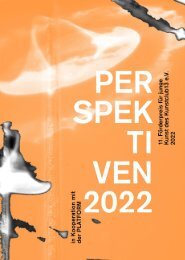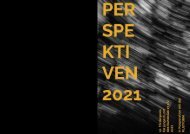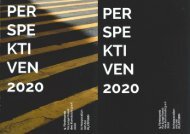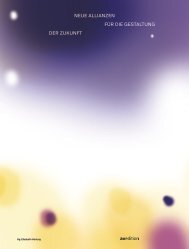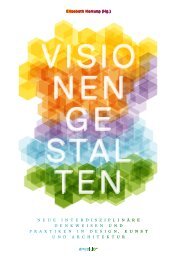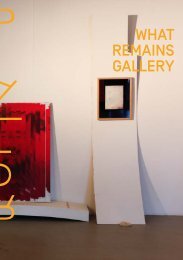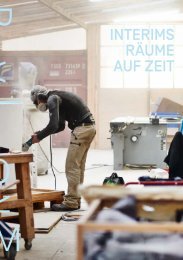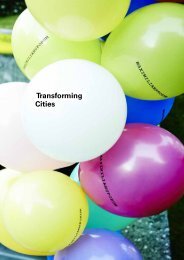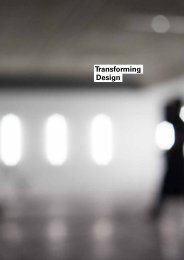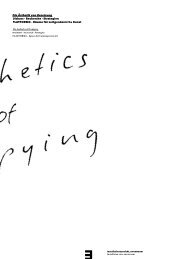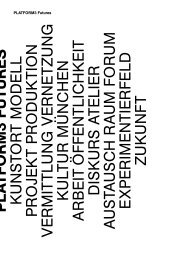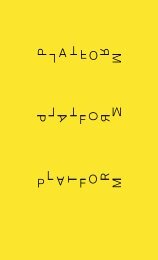Erfolgreiche ePaper selbst erstellen
Machen Sie aus Ihren PDF Publikationen ein blätterbares Flipbook mit unserer einzigartigen Google optimierten e-Paper Software.
Sofia Spionage<br />
Yanna Varbanova<br />
Liquid Archives – Notes on Relations, Ruptures and Silences<br />
Anna Schneider<br />
Sofia Spionage is an interdisciplinary project<br />
that represents the contemporary visual existence<br />
of a city/capital in times of development<br />
and change. Through the instruments of<br />
art, the aim of the project is to create a picture<br />
and a feeling of one city and his inhabitants,<br />
still searching for their lost identity. Sofia and<br />
her face – “The city in pictures” (Photographic<br />
exhibition by Boyan Hristov and installation by<br />
Ivan Paskalev), “The city in words” (Curatorial<br />
lecture by Vladiya Mihailova), “The city in<br />
movement” (Visual action by HR-Stamenov),<br />
“The city in melodies” (Audio-musical performance<br />
by Kliment Dichev and Vladislav<br />
Iliev), “The city in colors and sounds” (Compilation<br />
of short movies about Sofia). The project<br />
is an attempt to create a vivid and spirited<br />
presentation of city and his many faces. Sofia<br />
Spionage is a colorful postcard with black<br />
and white edges that holds many wonderful<br />
melodies and hidden secrets inside. You just<br />
need to open it!!!<br />
Sofia Spionage is an event organised by<br />
Platform3 and the Department for Arts and<br />
Culture of the City of Munich. This project is<br />
supported by the Robert Bosch Foundation.<br />
Participating Artists: Boyan Hristov, Ivan Paskalev, Vladiya Mihailova,<br />
HR-Stamenov, Kliment Dichev and Vladislav Iliev | Curator: Yanna<br />
Varbanova, fellow of the program, “Cultural Managers from Central<br />
and Eastern Europe”, Robert Bosch Foundation<br />
“History is the fruit of power, but power itself<br />
is never so transparent that its analysis becomes<br />
superfluous. The ultimate mark of power may<br />
be its invisibility; the ultimate challenge, the exposition<br />
of its roots.” Michel-Rolph Trouillot, Silencing the<br />
Past: Power and the Production of History.<br />
Opening in December <strong>2009</strong>, the exhibition Liquid<br />
Archives – Notes on Relations, Ruptures and<br />
Silences, presents new and existing works of<br />
emerging and established contemporary artists.<br />
The central concern of the exhibition is a<br />
critical investigation into the production of<br />
history. The idea that history is an irrevocable,<br />
grand narrative, fed by the depths of an irrefutable<br />
static archive, is deconstructed. The<br />
notion of a “liquid archive“ stands for an alternative<br />
access to global history and political<br />
present. This change of perspective is enabled<br />
by a consideration of the oceans. The notion<br />
of a maritime setting functions as a counterpoint<br />
to a terrestrial framework, which is indebted<br />
to the nation-state and border politics.<br />
The maritime perspective is driven by the<br />
vision of multilateral narratives, allowing a<br />
wider spatial and longer temporal trajectory.<br />
The fine line between truth and fiction,<br />
between the reception of histories and their<br />
production, that inevitably is characterized<br />
by an uneven access to the means of the production<br />
of history (language, translation and<br />
its mediation), are fundamental structural<br />
aspects that are equally relevant in exhibitionmaking.<br />
By evoking an imaginary, by staging a<br />
narrative, an exhibition fictionalizes the real<br />
and thereby is itself a part of the production of<br />
history. The exhibition Liquid Archives – Notes<br />
on Relations, Ruptures and Silences aims to<br />
make these structural antinomies, that entail<br />
their own discourse of power, visible through<br />
curatorial concept and exhibition design.<br />
Participating Artists: Nadim Asfar (Lebanon), Ursula Biemann<br />
(Switzerland), Annegret Bleisteiner (Germany), Frédéric Bruly<br />
summary<br />
210 | 211




